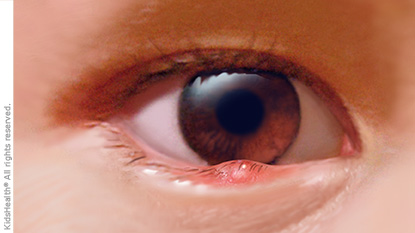Styes
Article Translations: (Spanish)
What Are Styes?
A stye is a small bump on your top or bottom eyelid, right where your eyelashes are. It can get red, swollen, and painful.
Why Do Styes Happen?
Styes form because a gland in your eye is clogged. They're too small to see, but you have lots of little glands in your eyelid. They make a special oil that mixes with your tears to keep your eyes wet even when you're not crying.
Sometimes old oil, skin cells, and dead germs get into a gland and clog it up so the oil can't get out. That makes the gland get bigger and bigger. Ouch! That's when you'll feel a stye and see it, too.

What Should I Do About a Stye?
If you think you have a stye, tell a parent or the adult who's caring for you. A stye is usually a minor problem that can be treated. A parent can call your doctor to see if you should come in for a visit. Or the doctor might just give your parent some advice over the phone.
Often, a doctor will recommend a nice warm washcloth. Warmth will help unclog the gland and get the gunk to drain out. Ask a grownup to get it to the right temperature if you're not sure (you don't want to use hot water). And wring it out so it's not too drippy.
Find a comfy place to relax and put the warm washcloth over your eye. Do this a few times a day. If the washcloth gets cool, you can warm it back up with warm water.
Sometimes, your doctor might recommend watered-down baby soap as a gentle cleanser for your eye. You don't want to put any old soap in your eyes because it will burn!
You'll need to see a doctor if your stye doesn't get better or if it gets worse. Your doctor might give you a medicated cream or other medicine to take.
Can I Prevent Styes?
To prevent styes, be careful about touching your eyes. That's how germs get in there. Washing your hands well and often is a good idea too.
Some kids get styes a lot. It might have something to do with the kind of skin they have. If that sounds like you, your doctor will have ideas on how to treat and prevent them.
Note: All information is for educational purposes only. For specific medical advice, diagnoses, and treatment, consult your doctor.
© 1995-2024 KidsHealth ® All rights reserved. Images provided by iStock, Getty Images, Corbis, Veer, Science Photo Library, Science Source Images, Shutterstock, and Clipart.com

